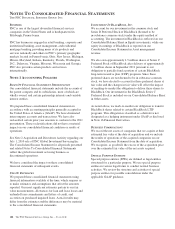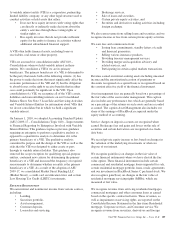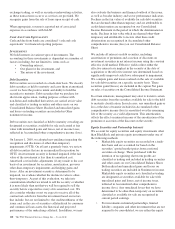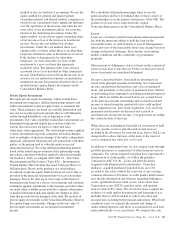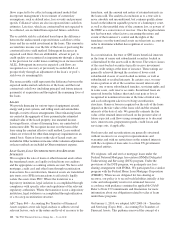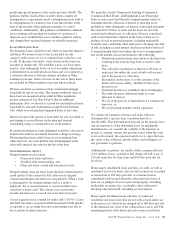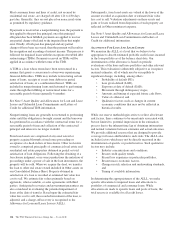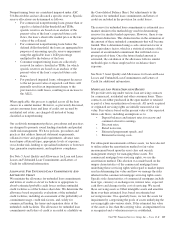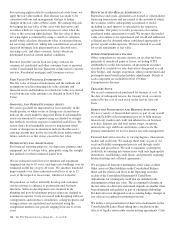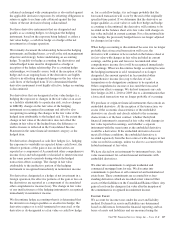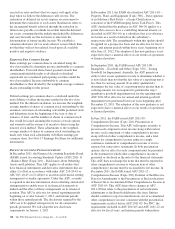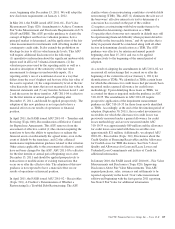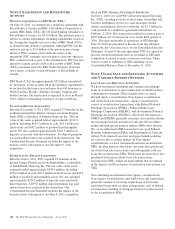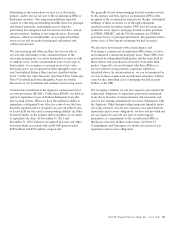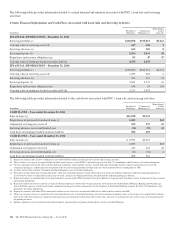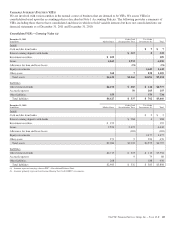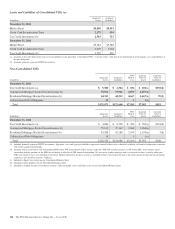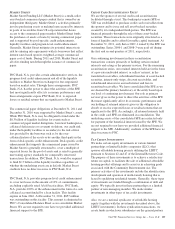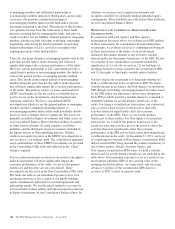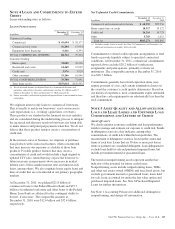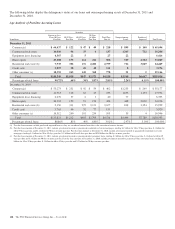PNC Bank 2011 Annual Report Download - page 127
Download and view the complete annual report
Please find page 127 of the 2011 PNC Bank annual report below. You can navigate through the pages in the report by either clicking on the pages listed below, or by using the keyword search tool below to find specific information within the annual report.enacted tax rates and laws that we expect will apply at the
time when we believe the differences will reverse. The
realization of deferred tax assets requires an assessment to
determine the realization of such assets. Realization refers to
the incremental benefit achieved through the reduction in
future taxes payable or refunds receivable from the deferred
tax assets, assuming that the underlying deductible differences
and carryforwards are the last items to enter into the
determination of future taxable income. We establish a
valuation allowance for tax assets when it is more likely than
not that they will not be realized, based upon all available
positive and negative evidence.
E
ARNINGS
P
ER
C
OMMON
S
HARE
Basic earnings per common share is calculated using the
two-class method to determine income attributable to common
shareholders. Unvested share-based payment awards that
contain nonforfeitable rights to dividends or dividend
equivalents are considered participating securities under the
two-class method. Income attributable to common
shareholders is then divided by the weighted-average common
shares outstanding for the period.
Diluted earnings per common share is calculated under the
more dilutive of either the treasury method or the two-class
method. For the diluted calculation, we increase the weighted-
average number of shares of common stock outstanding by the
assumed conversion of outstanding convertible preferred stock
and debentures from the beginning of the year or date of
issuance, if later, and the number of shares of common stock
that would be issued assuming the exercise of stock options
and warrants and the issuance of incentive shares using the
treasury stock method. These adjustments to the weighted-
average number of shares of common stock outstanding are
made only when such adjustments will dilute earnings per
common share. See Note 17 Earnings Per Share for additional
information.
R
ECENT
A
CCOUNTING
P
RONOUNCEMENTS
In December 2011, the Financial Accounting Standards Board
(FASB) issued Accounting Standards Update (ASU) 2011-11
- Balance Sheet (Topic 210) – Disclosures about Offsetting
Assets and Liabilities. This ASU applies to all entities that
have financial instruments and derivative instruments that are
either (1) offset in accordance with either ASC 210-20-45 or
ASC 815-10-45 or (2) subject to an enforceable master netting
arrangement or similar agreement. Under this ASU, an entity
is required to disclose information about offsetting and related
arrangements to enable users of its financial statements to
understand the effect of those arrangements on its financial
position. This ASU is effective for annual reporting periods
beginning on or after January 1, 2013, and interim periods
within those annual periods. The disclosures required by the
ASU are to be applied retrospectively for all comparative
periods presented. We will adopt the new disclosure
requirements on January 1, 2013.
In December 2011, the FASB also finalized ASU 2011-10 –
Property, Plant, and Equipment (Topic 360) – Derecognition
of in Substance Real Estate – a Scope Clarification (a
consensus of the FASB Emerging Issues Task Force). This
ASU clarified that the guidance in ASC 360-20 applies to a
parent that ceases to have a controlling financial interest (as
described in ASC 810-10) in a subsidiary that is in substance
real estate as a result of default on the subsidiary’s
nonrecourse debt. The amendments within this update should
be applied on a prospective basis and are effective for fiscal
years, and interim periods within those years, beginning on or
after June 15, 2012. The adoption of this new guidance is not
expected to have a material effect on our results of operations
or financial position.
In September 2011, the FASB issued ASU 2011-08 –
Intangibles – Goodwill and Other (Topic 350) – Testing
Goodwill for Impairment. Annually, the ASU permits an
entity to first assess qualitative factors to determine whether it
is more likely than not that the fair value of a reporting unit is
less than its carrying amount. If an entity qualitatively
determines the fair value of a reporting unit is greater than its
carrying amount, it is not required to perform the step 1
quantitative goodwill impairment test for the reporting unit.
ASU 2011-08 is effective for annual and interim goodwill
impairment tests performed for fiscal years beginning after
December 15, 2011. The adoption of this new guidance is not
expected to have a material effect on our results of operations
or financial position.
In June 2011, the FASB issued ASU 2011-05 -
Comprehensive Income (Topic 220), Presentation of
Comprehensive Income. This ASU will require an entity to
present each component of net income along with total net
income, each component of other comprehensive income
along with total other comprehensive income, and a total
amount for comprehensive income either in a single
continuous statement of comprehensive income or in two
separate but consecutive statements. In both presentation
options, the tax effect for each component must be presented
in the statement in which other comprehensive income is
presented or disclosed in the notes to the financial statements.
This ASU does not change the items that must be reported in
other comprehensive income or when an item of other
comprehensive income must be reclassified to net income. In
December 2011, the FASB issued ASU 2011-12 –
Comprehensive Income (Topic 220), Deferral of the Effective
Date for Amendments to the Presentation of Reclassifications
of Items Out of Accumulated Other Comprehensive Income in
ASU 2011-05. This ASU defers those changes in ASU
2011-05 that relate to the presentation of reclassification
adjustments as the Board redeliberates this item. Entities
should continue to report reclassifications out of accumulated
other comprehensive income consistent with the presentation
requirements in effect before ASU 2011-05. For PNC, the
requirements included in ASU 2011-05 and ASU 2011-12 are
effective for fiscal years, and interim periods within those
118 The PNC Financial Services Group, Inc. – Form 10-K


